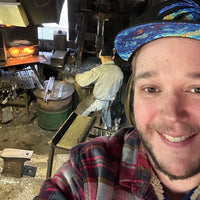How to Use Your Konro Grill
You've just taken home your new fancy Konro grill! You're well on your way to experiencing the joy of backyard yakitori and other grilled treats. You dig out the instructions, and your heart sinks as you realize that it’s all in Japanese. If you're anything like me and can't read Japanese. Oh no! But don't worry ,we've got your back. Here is a translation of the basic instructions you'll find in all Konro boxes:
Preparing and Lighting Your Konro Grill
You only need enough charcoal to cover the bottom of the Konro, anything more will cause excessive heat and flame. To light your Binchotan, Ogatan, or lump charcoal, load it into a charcoal chimney and light it from the bottom with newspaper or a gas burner. Dense binchotan lights best with some cheaper charcoal or kindling to help light it. After it is fully lit and glowing, pour it into your grill and spread it out to evenly cover the bottom. I find King Tong are great for manipulating hot charcoal.
Use the vents to adjust heat: open vents mean more oxygen gets to the coals, which in turn means higher temperature. Binchotan lasts a long long time, but if you do need to add some, only add enough to keep the bottom of the Konro covered.

Now You're Cooking with Charcoal!
If you have a Yakitori-sized grill and are using our bamboo skewers, you can just rest your food right across the grill. If you’re on a wider grill or cooking without skewers, be sure to pre-heat your grate and oil it lightly before you get cooking.
Charcoal burns hot, but takes time to get going, so be patient. Once it gets hot, it'll stay that way for hours with quality charcoal!
How to Dispose of Hot Charcoal
Snuff the charcoal out in a thick cast iron dutch oven or dunk them into water in a bucket. If you have a large enough roasting tray, you can even close the vents and smother the top of the grill with a tray. Once dried, leftover pieces of Binchotan can be used again. DO NOT pour water on the Konro to put out the fire, or the Konro will break due to extreme temperature change. Only put away or store your Konro after it has cooled completely.
Here are the basic dos and don'ts of Konro ownership. Remembering these will help you have a safe and delicious cooking session:
- Charcoal gives off carbon monoxide. Use it only where there is enough ventilation. Never use indoors.
- The bottom of Konro will become extremely hot. Do not use it on carpets or tatami mats. Use only on a fireproof surface.
- Do not move the Konro while using.
- Do not leave the Konro unattended while using.
- Do not leave children unattended with a hot Konro.
- Make sure the fire is completely extinguished after use.
- The metal parts will get hot. Use caution when handling.
- The metal parts can be sharp and cause scrape or cuts. Be cautious when handling
- Traditional Konros are ceramic. When dropped or banged, it can break.
- Metal Konros can rust, so don't leave them uncovered outdoors.
- Never pour water into the Konro to put out the fire. This will cause the Konro to break.
- Store in a weatherproof area, do not leave outdoors. Avoid extreme humidity.
- Use the Konro on the flat and level surface.
- If the Konro gets wet, it will not work as well as it should. Let the Konro dry completely before the next use.





